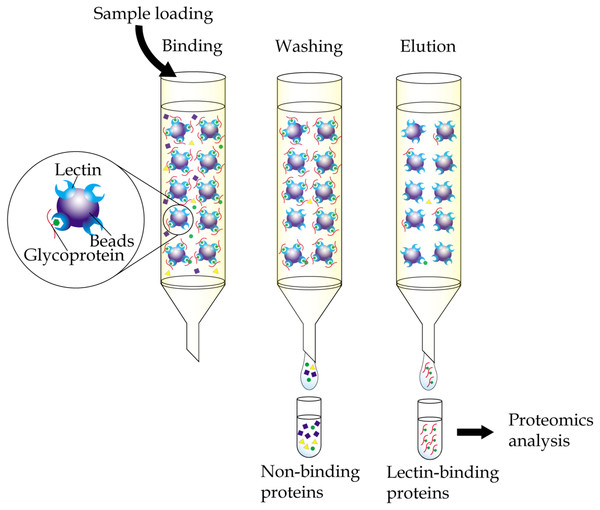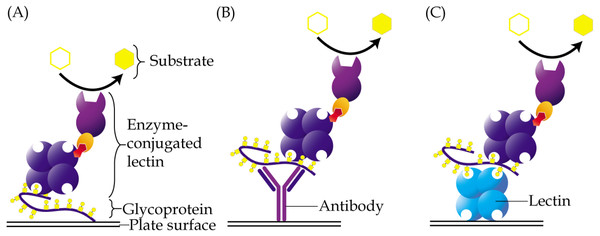Glycoprotein Detection Service by Affinity based Procedure
Affinity-based glycoprotein detection is an important part of the researches in glycosylation engineering. With advanced technologies and experienced scientists, Creative Biolabs has successfully developed a high-sensitive glycoprotein detection platform to offer the largest and most diverse portfolio of glycoprotein detection products or services. We can provide a series of affinity-based methods to determine whether a protein is glycosylated.
Introduction of Glycoprotein Analysis
Glycoproteins have a wide range of physiological functions, including protein folding and trafficking, cell-cell and cell-matrix interaction, cellular differentiation, fertilization, immune response, the initiation and metastasis of tumors, etc. But, because of the low abundance of glycoproteins, the complexity of the glycan structures and the multiple substitutions (microheterogeneity) at glycosylation sites, glycoprotein analysis is very complicated and difficult.
Glycoprotein Detection by Affinity-Based Procedures
We can provide a series of technologies for glycoprotein detection and analysis. Affinity-based glycoprotein detection methods have a wide spectrum of applications because they are more specific and they can facilitate the determination of the glycosylation type.
-
Saccharide-Binding Proteins
 Fig.1 Workflow of immobilized-lectin affinity chromatography.1
Fig.1 Workflow of immobilized-lectin affinity chromatography.1
Lectins are carbohydrate-binding proteins that can specifically bind mono- or oligosaccharides to discriminate and analyze the glycan structures of glycoproteins. In the last decades, lectin-based applications for glycoprotein detection and characterization have been widely applied and it can detect glycoproteins separated by gel electrophoresis (SDS-PAGE) or two-dimensional gel electrophoresis (2D SDS-PAGE). During the lectin blotting procedure, protein samples are resolved on SDS-PAGE and transferred onto a nitrocellulose or polyvinylidene fluoride (PVDF) membrane, which is then incubated with a specific lectin and labeled with a group, such as digoxigenin (DIG) or biotin that will further bind to a secondary antibody or to avidin, subsequently, they are conjugated to an enzyme that catalyzes a color-producing reaction (alkaline-phosphatase) or a more sensitive luminescence-producing reaction (horseradish peroxidase).
Notably, when the lectin blotting method is combined with the high resolution and reproducibility of 2D SDS-PAGE and with the sensitivity of enhanced chemiluminescence, it can identify rapidly the glycoproteins of interest by comparison with a reference 2D SDS-PAGE protein map, and to obtain reliable and reproducible results.
-
Enzyme-Based Methods
Glycoproteins may be detected and isolated by specific enzymes, which has been employed for the improved detection of glycoproteins on blots. For instance, GALT (β-1,4-galactosyltransferase) can specifically add an azidogalactose to GlcNAc, that may be a marker for some proteins that are O-β-GlcNAcylated. O-GlcNAc can react with a fluorescent alkyne, leading to the detection by UV gel imager. Moreover, O-GlcNAcylated peptides can be labeled and further analyzed by mass spectrometry (MS).
-
Antibody-Based Methods
The primary antibodies may specifically recognize some unique glycan moieties of glycoproteins, and they can react with secondary antibodies conjugated to enzymes that catalyze a color- or luminescence-producing reaction, which is exploited in glycoprotein detection with extraordinary high sensitivity and specificity.
 Fig.2 Different approaches of enzyme-linked lectin assay.1
Fig.2 Different approaches of enzyme-linked lectin assay.1
Why choose us?
-
High sensitivity and specificity
-
Extensive experience and advanced biotechnologies
-
Fully customizable experimental design
-
Competitive price with the best quality
-
Best after-sale service
Working with Us to Promote Your Success!
With years of experience, Creative Biolabs has successfully completed a lot of therapeutic glycoprotein detection projects. Because of the high sensitivity and specificity, affinity-based glycoprotein detection method helps us win a good reputation in our worldwide clients. Our scientists are committed to applying the high-quality products and services to meet your specific needs in glycoprotein project. The values of quality, timing and price is our basic criterion. If you are interested, please contact us without hesitation.
Published data
Lectins recognize specific carbohydrate fractions of glycoproteins. It is an effective tool for the detection of cancer biomarkers (tumor-associated glycopeptides) and has been used to develop a variety of affinity-based glycoprotein detection techniques. This article provides us with a detailed description of several detection techniques, including lectin blotting, lectin histochemistry, enzyme-linked lectin assay, immobilized lectin affinity chromatography, and lectin arrays, and their applications in cancer biomarker identification. Each of these lectin-based detection techniques has its advantages. For example, lectin affinity chromatography does not require purified glycoproteins or glycans and has high affinity. Enzyme-linked lectin assay requires only a very small amount of sample for detection, is relatively high-throughput, and is easy to perform. By understanding each of the lectin-based assays in this study, we can better select the appropriate method to detect glycoproteins in different samples.1
FAQs
Q1: How specific are the affinity programs used for glycoprotein assays?
A1: We provide highly specific glycoprotein detection services. Depending on the specific research purpose, we use affinity ligands, such as lectins and antibodies, to recognize specific glycan structures, enabling precise detection and isolation of glycoproteins.
Q2: Are your glycoprotein detection protocols fixed?
A2: Of course not, we have extensive experience in glycoprotein detection. After defining the client's needs and research objectives, we will customize the assay protocol and select the appropriate affinity ligands to ensure that the research needs are fully met.
Customer Review
Fitted Glycoprotein Assay Program
"Creative Biolabs developed a well-fitting glycoprotein assay program for us. They demonstrated to us their extensive experience and knowledge base in utilizing affinity-based procedures to detect glycoproteins. Accurate test results and detailed analysis reports also helped us to further carry out follow-up studies. This service has been invaluable to our glycoprotein research."
Accurate Glycoprotein Assay
"Creative Biolabs was fantastic. Their range of affinity-based programs made glycoprotein testing very easy and accurate. Throughout the detection process, their researchers were responsive and answered all the questions we had the first time. We were very pleased and impressed with the glycoprotein detection service and programs they provided."
Reference
-
Hashim, Onn Haji, Jaime Jacqueline Jayapalan, and Cheng-Siang Lee. "Lectins: an effective tool for screening of potential cancer biomarkers." PeerJ 5 (2017): e3784. Distributed under Open Access license CC BY 4.0, without modification.
For Research Use Only.
Related Services

 Fig.1 Workflow of immobilized-lectin affinity chromatography.1
Fig.1 Workflow of immobilized-lectin affinity chromatography.1
 Fig.2 Different approaches of enzyme-linked lectin assay.1
Fig.2 Different approaches of enzyme-linked lectin assay.1



